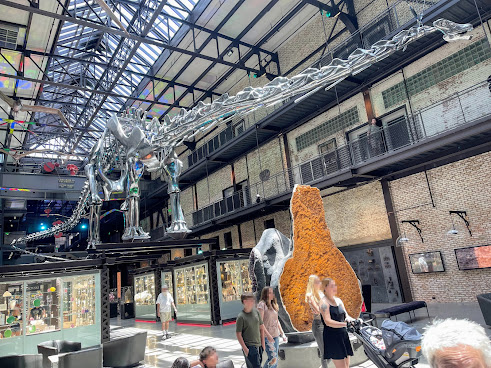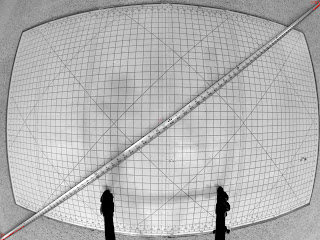My wife, Jill, and I were in the Savannah, Georgia area at the end of June and beginning of July. We spent the first part of the trip exploring the built environment. Savannah is a fun, diverse city with a lot to do. We found this amazing metallic Diplodocus in the lobby of the JW Marriott Savannah Plant Riverside District hotel:
 |
| JW Marriott Savannah Plant Riverside hotel lobby |
We found lovely Spanish-moss-draped Live Oaks in the parks - this is Forsyth Park:
 |
| Forsyth Park |
We found more of them in the cemeteries - this is Bonaventure Cemetery:
 |
| Bonaventure Cemetery |
We found the amazing Cathedral Basilica of St. John the Baptist:
 |
| Cathedral Basilica of St. John the Baptist |
 |
| Cathedral Basilica of St. John the Baptist |
We found many blooming Crepe Myrtles, draped in, of course, Spanish Moss:
 |
| Crepe Myrtle |
We were staying on Tybee Island, which is about 30-45 minutes from downtown Savannah. On the island, we visited the Tybee Island Light Station, which was to feature prominently in our photos for the next few days:
 |
| Tybee Light Station |
We went to the top of the lighthouse, where I took 8 images from each cardinal half-point of the compass (N, NE, E, etc.), and had Photoshop stitch them together in this panorama. Note that Photoshop invented details around the edges, so you will see strange duplications (link to Google Photos version, here, which lets you view as a panorama):
 |
| View from Tybee Lighthouse |
Since Tybee Island is on the east coast, sunsets were not over the ocean. However, they were still pretty when they happened over the salt marshes:
 |
| Sunset over Tybee Island |
We stayed in two different places while on Tybee Island. The second, and most picturesque, was the Tybee Island Inn. Its front yard is covered by, what else, a Live Oak draped in Spanish Moss:
 |
| Tybee Island Inn |
Our room was upstairs, and it had a balcony into that front yard area. Here is a panorama from that balcony. It was like staying in a treehouse (
Google Photos version here):
 |
| Balcony at Tybee Island Inn |
The room we stayed in was called the Lighthouse Room, because the Tybee Lighthouse is visible from the balcony:
 |
| Tybee Lighthouse |
Our final major built-environment exploration was at
Fort Pulaski, a 19th-century fort that was the site of a battle between Union and Confederate forces in 1862. The Confederate smooth-bore cannon (shooting traditional round cannon balls) were no match for the Union rifled cannon (shooting bullet-shaped spinning projectiles). The Union guns had something like 3 times the range of the Confederate guns, so they just set them up outside Confederate range and pounded the fort until its ammunition depot was threatened. The fort then surrendered. The damage was partially repaired, but some is still visible:
 |
| Fort Pulaski |
Near the fort stands the Cockspur Lighthouse. No longer operational, it is the site of several local legends, including the
Waving Girl. In this picture, you can see the still-operational Tybee Lighthouse in the background:
 |
| Cockspur Lighthouse |
With most of our people-centric tourism out of the way, we dedicated the second half of our trip to wildlife. We were on the hunt for Painted Buntings, which we were very happy to find:
 |
| Painted Bunting |
This fellow was actually on the hunt for a Painted Bunting, too. He was looking for a female, which he found. He did a mating dance, although he was ultimately unsuccessful, as the female called him off at the last second (possibly due to the proximity of people; it might have been unwise to emulate
the seventh track of side two of the Beatles' White album):
 |
| Painted Bunting Dance |
We were also very excited to find many Wood Storks, including a rookery with many adults and chicks:
 |
| Wood Stork and Chick |
 |
| Wood Stork launching |
 |
| Wood Stork in flight |
A first for us (for photos, anyway) were the Pileated Woodpeckers:
 |
| Pileated Woodpeckers |
We found many other wading birds, including, but not limited to (in order below) Great Egrets, Snowy Egrets, Green Herons, Little Blue Herons, Black-crowned Night Herons, and Tricolored Herons:
 |
| Tricolored Heron |
Many raptors call the Savannah area home, including (in order) Mississippi Kites, Turkey Vultures, Black Vultures, Osprey, and Red-shouldered Hawks:
 |
| Mississippi Kite |
 |
| Turkey Vulture |
 |
| Black Vultures |
 |
| Osprey |
 |
| Red-shouldered Hawk |
And other birds, too many to name, but here are a few:
 |
| Eastern Bluebird |
 |
| Red-bellied Woodpeckers |
 |
| Pine Warbler |
 |
| Red-headed Woodpecker |
 |
| Carolina Chickadee |
 |
| Tufted Titmouse |
 |
| Boat-tailed Grackle |
 |
| Hairy Woodpecker (Eastern variety) |
 |
| Tern (L) and Black Skimmer (R) |
 |
| Great Crested Flycatcher |
 |
| Northern Cardinal |
 |
| Northern Parula |
 |
| Brown Pelican |
As usual, we did not limit ourselves to birds. We saw other animals, too, including:
 |
| Joro Spider (non-native) |
 |
| Butterfly |
 |
| Fiddler Crabs |
 |
| White-tailed Deer |
 |
| Dragonfly |
 |
| Five-lined Skink |
 |
| Alligator |
 |
| Bullfrog |
 |
| Hermit Crab |
 |
| Turtle (hard to tell what species) |
 |
| Millipede |
 |
| Leaf-footed Bug |
You can find a Google Photos album with these photos and more
here. I do want to note two areas where we found many of these animals. First, the
Skidaway Island State Park had many miles of hiking trails and lots of good habitat. Second, the
Oatland Island Wildlife Center, which is a fantastic asset of the local school system, which makes it available to the general public. Although it has captive local animals, it also has many miles of trail where wild birds and other critters may be found.
As a final parting photo, this one sums up the built environment and the natural environment which will take over if people ever stop keeping it at bay:
 |
| Building returning to the forest |


























































Comments